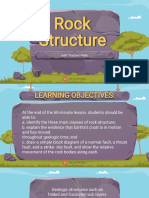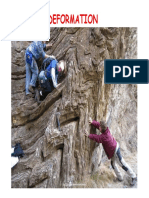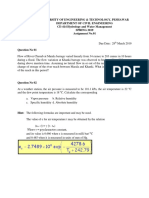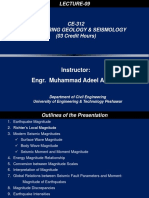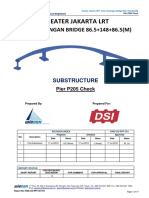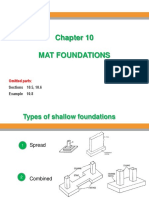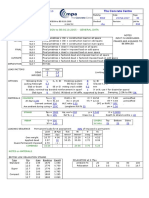Lecture - 4 Geological Structures
Lecture - 4 Geological Structures
Uploaded by
Khalid KhanCopyright:
Available Formats
Lecture - 4 Geological Structures
Lecture - 4 Geological Structures
Uploaded by
Khalid KhanOriginal Title
Copyright
Available Formats
Share this document
Did you find this document useful?
Is this content inappropriate?
Copyright:
Available Formats
Lecture - 4 Geological Structures
Lecture - 4 Geological Structures
Uploaded by
Khalid KhanCopyright:
Available Formats
LECTURE-05
CE-312
ENGINEERING GEOLOGY & SEISMOLOGY
(03 Credit Hours)
Instructor:
Engr. Muhammad Adeel Arshad
Department of Civil Engineering
University of Engineering & Technology Peshawar
Outlines of the Presentation
1. What are Geological Structures?
2. Rock Deformation
3. What Controls The Style of Strain
4. Behavior of Rocks under Stresses
5. Types of Stresses
6. Folds
7. Fractures
8. Joints and Faults
Courtesy: Dr. Irshad Ahmad
Engg. Geology & Seismology (CE-312) Instructor: Engr. Muhammad Adeel Arshad 2
What are Geological Structures?
Geological structures are dynamically-produced patterns or
arrangements of rock or sediment that result from, and give information
about, forces within the Earth. These are produced as rocks change
shape and orientation in response to applied stress.
Structural Geology is that branch of geology which talks about geological
structures. It is mainly concerned with shapes, arrangement,
interrelationships of bedrock units & forces that cause them.
Courtesy: Dr. Irshad Ahmad
Engg. Geology & Seismology (CE-312) Instructor: Engr. Muhammad Adeel Arshad 3
Rock Deformation
Large scale deformation of the Earth’s crust = Plate Tectonics
Smaller scale deformation = Structural Geology
Folds and faults are geological structures
Structural geology is the study of the deformation of rocks and the
effects of this movement
Courtesy: Dr. Irshad Ahmad
Engg. Geology & Seismology (CE-312) Instructor: Engr. Muhammad Adeel Arshad 4
Rock Deformation
Strain: Changes in volume or shape of a rock body
Stress: The force that acts on a rock unit to change its shape and/or its
volume causes strain or deformation.
Types of Directed Stress include:
Compression
Tension
Shear
Rock Strength: Ability of an object to resist deformation
Compressive: Capacity of a material to withstand axially directed pushing
forces – when the limit of compressive strength is reached, materials are
crushed
Tensile: Measures the force required to pull something such as rope, wire,
or a rock to the point where it breaks
Courtesy: Dr. Irshad Ahmad
Engg. Geology & Seismology (CE-312) Instructor: Engr. Muhammad Adeel Arshad 5
Behavior of Rocks under Stress
Elastic deformation
Deformation is reversible, after stress is removed, materials return to
original shape, i.e. A rubber band
Plastic deformation
Deformation is permanent
Rock flow in response to stress
Need high pressures and temperatures, generally deep in earth’s
interior.
Brittle deformation
Deformation is permanent
Rock break (fracture) or lose cohesion
Generally low temperature and low pressure, common in shallow crust
Courtesy: Dr. Irshad Ahmad
Engg. Geology & Seismology (CE-312) Instructor: Engr. Muhammad Adeel Arshad 6
What Controls The Style of Strain
Material Under a set of conditions, one material may deform plastically while
others may be elastic or brittle. (For example, at room temperature, steel is
elastic, fresh potato chips are brittle, and mashed potatoes are elastic or plastic.)
Magnitude of stresses (At low stress, most deformation is elastic. At higher
stresses ductile or brittle deformation occurs)
Pressure & Temperature Rocks near the surface, where temperatures and
confining pressures are low, usually behave like brittle solids and fracture once
their strength is exceeded
Strain Rate Brittle deformation usually occurs at high strain rate
Time Forces that are unable to deform rock when first applied may cause rock to
flow if the force is maintained over a long period of time.
History of the material (pre-existing cracks and crystal defects)
The variation of these factors determines if a rock will fault or fold
Courtesy: Dr. Irshad Ahmad
Engg. Geology & Seismology (CE-312) Instructor: Engr. Muhammad Adeel Arshad 7
Types of Stresses
Tensional (Extension) Stress
Compressional Stress
Shear Stress
Courtesy: Dr. Irshad Ahmad
Engg. Geology & Seismology (CE-312) Instructor: Engr. Muhammad Adeel Arshad 8
Types of Stresses
Tensional or Extensional Stresses
Stress move away from each other
(pull apart)
Rock lengthens
Common in divergent boundaries, but
not sole locale
Ductile deformation – stretching and
thinning of rock
Brittle deformation – fracturing and
faulting
Courtesy: Dr. Irshad Ahmad
Engg. Geology & Seismology (CE-312) Instructor: Engr. Muhammad Adeel Arshad 9
Types of Stresses
Compressional Stresses
Stress presses (squeezes) rock
together
Rock shortens
Common at convergent boundaries
Ductile deformation – shortening and
thickening of rock – rock folds
Brittle deformation – fracturing and
faulting
Courtesy: Dr. Irshad Ahmad
Engg. Geology & Seismology (CE-312) Instructor: Engr. Muhammad Adeel Arshad 10
Types of Stresses
Shear Stresses
Stress creates a lateral shift in the
rock
Rock slides past other rock
Common at transform boundaries
Results in faults
Courtesy: Dr. Irshad Ahmad
Engg. Geology & Seismology (CE-312) Instructor: Engr. Muhammad Adeel Arshad 11
Folds
If rocks is subjected to stresses beyond those that their strength can
resist, strata are permanently deformed by either buckling or fracturing.
The type of deformation depends on the mechanical properties of the
rocks and the nature of the stresses.
In general, stresses which are applied slowly, either deep within the Earth
where the confining pressure produced by overburden is high, or to rocks
that are not brittle, tend to produce folds by buckling or plastic flow.
Courtesy: Dr. Irshad Ahmad
Engg. Geology & Seismology (CE-312) Instructor: Engr. Muhammad Adeel Arshad 12
Folds
The wavy undulations in the rock beds are
called folds. This is when the rocks deform
by plastic deformation.
Folds are caused by pressures within the
Earth's crust resulting from plate-tectonic
activity. Rocks are slowly pushed and
compressed together, forming folds. Such
deformation usually occurs in sedimentary
layers that are softer and more flexible. If the
force is more sudden, and the rock more
brittle, then a fault forms instead of a fold.
They consist of arches and troughs in
alternate manner.
The size of folds vary greatly. Width of some
folds are measured in kilometers while those
of others in meters or centimeters.
Courtesy: Dr. Irshad Ahmad
Engg. Geology & Seismology (CE-312) Instructor: Engr. Muhammad Adeel Arshad 13
Fold Terminology
Anticline: It is an up fold where the
limbs dip away from the axis- it forms a
ridge.
Syncline: It is a down fold where the
limbs dip towards the axis- it forms
trough.
Limbs: The sloping side of a fold from
crest to trough is called the limb.
Axial Plane: It is an imaginary plane or
surface which divides the fold into
equal halves, marks location of
maximum curvature.
Hinge line: The center axis of a fold is
called the hinge line.
Courtesy: Dr. Irshad Ahmad
Engg. Geology & Seismology (CE-312) Instructor: Engr. Muhammad Adeel Arshad 14
Fold Symmetry
Symmetrical fold is one where the axial plane is vertical and the two
limbs have the same amount of dip.
Asymmetrical fold is one where the axial plane is inclined and the limbs
dip at different angles, and in opposite directions.
Courtesy: Dr. Irshad Ahmad
Engg. Geology & Seismology (CE-312) Instructor: Engr. Muhammad Adeel Arshad 15
Types of Folds
a. Syncline (the two limbs dip towards the axis- it forms trough)
b. Anticline (the two limbs dip away from the axis- it forms a ridge)
c. Isocline (the two limbs of a fold are essentially parallel to each other)
d. Overturned (the limbs of overturned folds dip in the same direction)
e. Recumbent (the limbs are essentially horizontal and parallel)
f. Overthrust (When pressure is very great a fracture occurs in the fold
and one limb is pushed forward over the other limb forming an
overthrust fold)
Monocline (folds with only one limb)
Courtesy: Dr. Irshad Ahmad
Engg. Geology & Seismology (CE-312) Instructor: Engr. Muhammad Adeel Arshad 16
Types of Folds
Anticline Fold
A fold with the oldest beds in the middle
Generally arched shaped, with limbs dipping away the center
Courtesy: Dr. Irshad Ahmad
Engg. Geology & Seismology (CE-312) Instructor: Engr. Muhammad Adeel Arshad 17
Types of Folds
Syncline Fold
A fold with the youngest beds in the middle
Generally trough shaped, with limbs dipping toward the center
Courtesy: Dr. Irshad Ahmad
Engg. Geology & Seismology (CE-312) Instructor: Engr. Muhammad Adeel Arshad 18
Types of Folds
Monocline Fold
Folds with only one limb
Often Associated with faults
Courtesy: Dr. Irshad Ahmad
Engg. Geology & Seismology (CE-312) Instructor: Engr. Muhammad Adeel Arshad 19
Types of Folds
Isocline Fold
The two limbs of a fold are essentially parallel to each other and are
nearly vertical
Courtesy: Dr. Irshad Ahmad
Engg. Geology & Seismology (CE-312) Instructor: Engr. Muhammad Adeel Arshad 20
Types of Folds
Overturned Fold
The limbs of overturned folds dip in the same direction and one limb has
been tilted beyond vertical
Courtesy: Dr. Irshad Ahmad
Engg. Geology & Seismology (CE-312) Instructor: Engr. Muhammad Adeel Arshad 21
Types of Folds
Recumbent Fold
The limbs of overturned folds dip in the same direction and are
essentially horizontal and parallel
Courtesy: Dr. Irshad Ahmad
Engg. Geology & Seismology (CE-312) Instructor: Engr. Muhammad Adeel Arshad 22
Types of Folds
Overthrust Fold
When pressure is very great a fracture occurs in the fold and one limb is
pushed forward over the other limb forming an overthrust fold
Courtesy: Dr. Irshad Ahmad
Engg. Geology & Seismology (CE-312) Instructor: Engr. Muhammad Adeel Arshad 23
Fractures
Fracture may be defined as the
surfaces along which rocks or
minerals have broken; they are
therefore surfaces across which the
material has lost cohesion.
The term fracture encompasses
both joints and faults.
Fractures have two parallel surfaces
that meet at the fracture front.
These surfaces are approximately
planar.
The relative displacement of originally
adjacent points across the fractures is
small compared to the fracture length.
Courtesy: Dr. Irshad Ahmad
Engg. Geology & Seismology (CE-312) Instructor: Engr. Muhammad Adeel Arshad 24
Types of Fractures
Three types of fractures have been identified:
Mode-I fractures (joints) it is the extensional fractures and formed by
opening with no displacement parallel to the fracture.
Mode-II and Mode-III are shear fractures. These are faults like
fractures one of them is strike -slip and the other is dip-slip
Same fracture can exhibit both Mode-II and Mode-III in different parts of
the region.
Courtesy: Dr. Irshad Ahmad
Engg. Geology & Seismology (CE-312) Instructor: Engr. Muhammad Adeel Arshad 25
Joints
Joints are fractures along which there has been no appreciable
displacement parallel to the fracture and only slight movement normal to
the fracture plane.
Joints are most common of all structures present in all settings in all kind
of rocks as well as consolidated and unconsolidated sedimentary basins.
Courtesy: Dr. Irshad Ahmad
Engg. Geology & Seismology (CE-312) Instructor: Engr. Muhammad Adeel Arshad 26
Types of Joints
Joints can be broadly classified as:
Systematic joints: have a subparallel orientation and regular spacing.
Nonsystematic joints: joints that do not share a common orientation and
those highly curved and irregular fracture surfaces. They occur in most
area but are not easily related to a recognizable stress.
Joint set: joints that share a similar orientation in same area.
Joint system: two or more joints sets in the same area.
Some times both systematic and nonsystematic joints formed in the same
area at the same time but nonsystematic joints usually terminate at
systematic joints which indicates that nonsystematic joints formed later.
Courtesy: Dr. Irshad Ahmad
Engg. Geology & Seismology (CE-312) Instructor: Engr. Muhammad Adeel Arshad 27
Types of Joints
Courtesy: Dr. Irshad Ahmad
Engg. Geology & Seismology (CE-312) Instructor: Engr. Muhammad Adeel Arshad 28
Faults
Faults are fractures that have appreciable movement parallel to their
plane. They are produced usually by seismic activity.
Understanding faults is useful in design for long-term stability of dams,
bridges, buildings and power plants. The study of fault helps understand
mountain building.
Faults may be hundred of meters or a few centimeters in length.
Faults may extend from the ground surface to depths of several tens of
kilometers.
Faults may be observable on ground surface, or may be buried.
Presence of faults DOES NOT necessarily mean that earthquakes will
occur. Their movement may be aseismic (very slow movement that
does not cause earthquakes) or the faults may be inactive (no
movement).
Courtesy: Dr. Irshad Ahmad
Engg. Geology & Seismology (CE-312) Instructor: Engr. Muhammad Adeel Arshad 29
Fault’s Terminology
Fault plane: Surface that the movement has taken
place within the fault. On this surface the dip and strike
of the fault is measured.
Hanging wall: The rock mass resting on the fault plane.
Footwall: The rock mass beneath the fault plane.
Slip: Describes the movement parallel to the fault
plane.
Dip slip: Describes the up and down movement
parallel to the dip direction of the fault.
Strike slip: Applies where movement is parallel to strike
of the fault plane.
Oblique slip: Is a combination of strike slip and dip slip.
Net slip (true displacement): Is the total amount of
motion measured parallel to the direction of motion.
Courtesy: Dr. Irshad Ahmad
Engg. Geology & Seismology (CE-312) Instructor: Engr. Muhammad Adeel Arshad 30
Fault’s Terminology
Scarp: The exposed upward block forms a cliff-like feature known as a fault
scarp. A scarp may range from a few to hundreds of meters in height and their
length may continue for 300 or more kilometers (around 200 miles).
Scarp
A normal dip-slip fault
Courtesy: Dr. Irshad Ahmad
Engg. Geology & Seismology (CE-312) Instructor: Engr. Muhammad Adeel Arshad 31
Fault’s Geometry
Strike(): It is the horizontal line produced by the
intersection of the fault plane and a horizontal plane. In
order to be unambiguous, the convention is to measure
the angle of the strike such that the hanging wall is to be
right (i.e. always measured clockwise from North).
Dip (): It is the downward slope of the fault plane;
angle between fault plane and the horizontal plane
measured perpendicular to strike.
Rake/Slip (): The direction of slip on a rupture can be
defined unambiguously by a single angle known as the
rake or slip. The rake is the angle between the strike
direction and the vector of slip of the hanging wall with
respect to the fault wall. It is measured in the plane of
the fault, positive upwards. A normal fault rupture has a
rake of –90° and a reverse rupture a rake of +90°.
Courtesy: Dr. Irshad Ahmad
Engg. Geology & Seismology (CE-312) Instructor: Engr. Muhammad Adeel Arshad 32
Types of Faults
Faults can be divided into several
different types depending on the
direction of relative displacement.
Since faults are planar features, the
concept of strike and dip also
applies, and thus the strike and dip
of a fault plane can be measured.
One division of faults is between
dip-slip faults, where the
displacement is measured along
the dip direction of the fault, and
strike-slip faults where the
displacement is horizontal, parallel
to the strike of the fault.
Courtesy: Dr. Irshad Ahmad
Engg. Geology & Seismology (CE-312) Instructor: Engr. Muhammad Adeel Arshad 33
Types of Faults
Normal Fault
The hanging wall has moved down
relative to the footwall.
Associated with tensile stresses in
crust.
The faulting in Oceanic Ridge
earthquakes is predominantly
Normal.
Horst – raised block of material
bounded by two normal faults.
Graben – trough (valley) bounded by
two normal faults.
Courtesy: Dr. Irshad Ahmad
Engg. Geology & Seismology (CE-312) Instructor: Engr. Muhammad Adeel Arshad 34
Types of Faults
Normal Fault
FOOTWALL
HANGINGWALL
Courtesy: Dr. Irshad Ahmad
Engg. Geology & Seismology (CE-312) Instructor: Engr. Muhammad Adeel Arshad 35
Types of Faults
Reverse Fault
In reverse fault, the hanging wall moves upward relative to foot wall.
Dip angle is generally more than 45o.
Associated with compressive stresses in crust.
Courtesy: Dr. Irshad Ahmad
Engg. Geology & Seismology (CE-312) Instructor: Engr. Muhammad Adeel Arshad 36
Types of Faults
Thrust Fault
A special type of reverse fault, in
which the dip of the fault is small
(large movements). Dip angle is
generally less than 30o.
Associated with compressive
stresses in crust.
Displacement can be 100’s km
(~60 miles).
Faulting in subduction zones are
mainly thrust-type.
Typically associated with folds.
Thrust Fault
Courtesy: Dr. Irshad Ahmad
Engg. Geology & Seismology (CE-312) Instructor: Engr. Muhammad Adeel Arshad 37
Types of Faults
Strike Slip Fault
Movement occurs parallel to strike.
Associated with shear stresses in crust.
There are two types of strike slip faults:
Right lateral strike-slip fault (dextral):
Where the side opposite the observer
moves to the right.
Left lateral strike-slip fault (sinistral):
Where the side opposite the observer
moves to the left.
Note that the same sense of movement will
also be observed from the other side of the
fault.
Courtesy: Dr. Irshad Ahmad
Engg. Geology & Seismology (CE-312) Instructor: Engr. Muhammad Adeel Arshad 38
Types of Faults
Oblique Fault
Movement with both dip-slip and strike-slip components.
Courtesy: Dr. Irshad Ahmad
Engg. Geology & Seismology (CE-312) Instructor: Engr. Muhammad Adeel Arshad 39
The End
Courtesy: Dr. Irshad Ahmad
Engg. Geology & Seismology (CE-312) Instructor: Engr. Muhammad Adeel Arshad 40
You might also like
- Slope Stability Analysis by Strength ReductionDocument6 pagesSlope Stability Analysis by Strength ReductionBoris Leal Martinez100% (1)
- Geology Trip Full ReportDocument43 pagesGeology Trip Full ReportZul Arami83% (6)
- 265 HcsDocument3 pages265 HcsNaveen NunnaNo ratings yet
- Guidelines For The Use of Advanced Numerical AnalysisDocument177 pagesGuidelines For The Use of Advanced Numerical AnalysisHuy Hiep Nguyen100% (3)
- Lecture - 2 Rocks, Igneous, Sedimentry & MetamorphicDocument63 pagesLecture - 2 Rocks, Igneous, Sedimentry & MetamorphicKhalid KhanNo ratings yet
- Geological StructuresDocument5 pagesGeological StructuresjaimeNo ratings yet
- Strucural Geoloy LecturesDocument77 pagesStrucural Geoloy LecturesSaheb BhaktaNo ratings yet
- Department of Studies in Earth ScienceDocument14 pagesDepartment of Studies in Earth SciencebhumiNo ratings yet
- Structural Geology IntroductoryDocument23 pagesStructural Geology IntroductoryAbdullah Al RashedNo ratings yet
- Geologic StructuresDocument6 pagesGeologic Structurescris ortonero100% (1)
- Geol ch6 Lect14 StructuralGeologyDocument46 pagesGeol ch6 Lect14 StructuralGeologyخيري سمير كمالNo ratings yet
- 5 EG - CE - Engineering Properties of Rocks PRT - PpsDocument60 pages5 EG - CE - Engineering Properties of Rocks PRT - PpsHisham EssaNo ratings yet
- Physical Geology 2nd Edition Chapter 12 Geological StructuresDocument22 pagesPhysical Geology 2nd Edition Chapter 12 Geological StructuresmakksNo ratings yet
- Structural Geology1Document135 pagesStructural Geology1dexter100% (1)
- Geo NotesDocument7 pagesGeo NotesFaria KhanNo ratings yet
- Geol 1 STRUCTURAL GEOLOGYDocument7 pagesGeol 1 STRUCTURAL GEOLOGYMelNo ratings yet
- G11 Earth Science - Week 4Document16 pagesG11 Earth Science - Week 4mn Kim100% (2)
- GEOLOGYDocument7 pagesGEOLOGYailenecandelario07No ratings yet
- Structural Geology PresentationDocument17 pagesStructural Geology PresentationTatenda PaduzeNo ratings yet
- Mechanical Properties of RocksDocument13 pagesMechanical Properties of RocksRizette Palogan100% (1)
- EG - Chapter 3. Surface ProcessesDocument58 pagesEG - Chapter 3. Surface ProcessesMaMtNo ratings yet
- Structural Geology Presentation-1Document8 pagesStructural Geology Presentation-1Tatenda PaduzeNo ratings yet
- 4 Geological StructuresDocument35 pages4 Geological StructuresZahoor Ahmad100% (1)
- Reporting in GeologyDocument4 pagesReporting in GeologyJovelane PanesNo ratings yet
- CHAPTER 4 GeoDocument7 pagesCHAPTER 4 GeoMiccu Navarro-VillegasNo ratings yet
- Perlita Rock StructureDocument29 pagesPerlita Rock StructureJohn Rey DumaguinNo ratings yet
- Rock Mechanics Acts 3-5Document6 pagesRock Mechanics Acts 3-5Jef Michael L. DahuylaNo ratings yet
- Structural Geology and Rock Mechanics 1Document60 pagesStructural Geology and Rock Mechanics 1Herlyn SpencerNo ratings yet
- Core Earth-Science Module-15-Q2 BautistaDocument7 pagesCore Earth-Science Module-15-Q2 Bautistakirstencoyoca10No ratings yet
- Structural GeologyDocument28 pagesStructural GeologyMiguel FeijaoNo ratings yet
- Chapter 7-Joints and Veins PDFDocument38 pagesChapter 7-Joints and Veins PDFgetasew100% (1)
- Lecture - 5 Weathering, Erosion & DepositionDocument35 pagesLecture - 5 Weathering, Erosion & DepositionKhalid Khan100% (1)
- Kuliah Struktur GeologiDocument75 pagesKuliah Struktur GeologiAshabul KahfiNo ratings yet
- Elsci Week4Document6 pagesElsci Week4olimpoarianekayeNo ratings yet
- EsciDocument5 pagesEsciemNo ratings yet
- Structural Geology GroundwaterDocument109 pagesStructural Geology Groundwaterkiran_ran99No ratings yet
- Structural Geology (Geol 305) SemesterDocument47 pagesStructural Geology (Geol 305) SemesterSyakiraTrisnafiahNo ratings yet
- Week 014 Module 12 - Stress and StrainDocument2 pagesWeek 014 Module 12 - Stress and Strain16 EDISON Alexa EstuitaNo ratings yet
- DiastrophismDocument54 pagesDiastrophismDave Cercado BugadorNo ratings yet
- Hemispherical Projection Methods in Rock Mechanics by SD PriestDocument11 pagesHemispherical Projection Methods in Rock Mechanics by SD PriestutshahoNo ratings yet
- CHAPTER THREE Fractures - JointDocument27 pagesCHAPTER THREE Fractures - Jointأمجد هاتف منفي جفالNo ratings yet
- Rock Behaviors Under Stress - Group5Document16 pagesRock Behaviors Under Stress - Group5SkY HoTdOgNo ratings yet
- Compression Shearing and Pulling ApartDocument27 pagesCompression Shearing and Pulling ApartOtiralc OcasionNo ratings yet
- Structural Geology IDocument55 pagesStructural Geology IAban RobertNo ratings yet
- Structural GeologyDocument90 pagesStructural GeologyBalsam Qusay Mohammed100% (1)
- Lec 4Document18 pagesLec 4yousifshli9999No ratings yet
- Rock Deformation and Earthquake FinalDocument131 pagesRock Deformation and Earthquake Finalniaz ahmedNo ratings yet
- TRINADocument6 pagesTRINAMuhammad AliNo ratings yet
- Lecture 4 - DeformationDocument83 pagesLecture 4 - DeformationNick jamesNo ratings yet
- Topic 5 June 2016 V3Document23 pagesTopic 5 June 2016 V3Nicat SəfərliNo ratings yet
- Report in ElsDocument2 pagesReport in ElsRowe AlmonteNo ratings yet
- Structural GeologyDocument35 pagesStructural GeologyYounas BilalNo ratings yet
- Deformation: Prof - Dr.Kadir Dirik Lecture NotesDocument38 pagesDeformation: Prof - Dr.Kadir Dirik Lecture Notesمحمد باسم محمد حسين ANo ratings yet
- Structure GeologyDocument51 pagesStructure Geologyusama_veronNo ratings yet
- Ss and Strain Rock Deformation Under Structural GeologyDocument13 pagesSs and Strain Rock Deformation Under Structural GeologyJenneth Cabinto DalisanNo ratings yet
- Diplom QuestionsDocument62 pagesDiplom QuestionsNarmina MamedovaNo ratings yet
- In CoalitionDocument8 pagesIn CoalitionIvanovich PimenovaNo ratings yet
- Structural Geology: A) Geological Maps B) Folds, Fault, & JointsDocument42 pagesStructural Geology: A) Geological Maps B) Folds, Fault, & JointsRolandNo ratings yet
- Seismic ExplorationDocument20 pagesSeismic Explorationmunther alawsiNo ratings yet
- 1.4 Introduction To DeformationDocument13 pages1.4 Introduction To DeformationVivek SudanNo ratings yet
- Structural Geology (Geol 305) SemesterDocument50 pagesStructural Geology (Geol 305) SemesterRoland Rawlins IgaborNo ratings yet
- Dr. Azealdeen Salih Al-Jawadi: Importance of Rock Mechanics and Its HistoryDocument5 pagesDr. Azealdeen Salih Al-Jawadi: Importance of Rock Mechanics and Its HistoryAzealdeen AlJawadiNo ratings yet
- Rock Collecting for Kids: An Introduction to GeologyFrom EverandRock Collecting for Kids: An Introduction to GeologyRating: 5 out of 5 stars5/5 (2)
- Assignment 01 - UETDocument1 pageAssignment 01 - UETKhalid KhanNo ratings yet
- 4 CE 414 Infiltration 1Document22 pages4 CE 414 Infiltration 1Khalid KhanNo ratings yet
- 3 CE 414 Precipitation ExamplesDocument20 pages3 CE 414 Precipitation ExamplesKhalid KhanNo ratings yet
- 2 CE 414 Meteorology IntroductionDocument15 pages2 CE 414 Meteorology IntroductionKhalid KhanNo ratings yet
- 3 CE 414 Precipitation TheoryDocument30 pages3 CE 414 Precipitation TheoryKhalid Khan100% (1)
- 1 CE 414 Hydrology IntroductionDocument34 pages1 CE 414 Hydrology IntroductionKhalid KhanNo ratings yet
- Measuring Earthquake Size-1Document49 pagesMeasuring Earthquake Size-1Khalid KhanNo ratings yet
- Seismic Hazard AssesmentDocument20 pagesSeismic Hazard AssesmentKhalid KhanNo ratings yet
- Strong Ground Motion-1Document43 pagesStrong Ground Motion-1Khalid KhanNo ratings yet
- Lecture - 5 Weathering, Erosion & DepositionDocument35 pagesLecture - 5 Weathering, Erosion & DepositionKhalid Khan100% (1)
- Assignment 4Document1 pageAssignment 4Khalid KhanNo ratings yet
- Seimology QuizDocument10 pagesSeimology QuizKhalid KhanNo ratings yet
- AssignmentDocument8 pagesAssignmentKhalid KhanNo ratings yet
- Science8 Q2 Module 3 Reduced FileDocument12 pagesScience8 Q2 Module 3 Reduced FileJames smithNo ratings yet
- PH.D Thesis PDFDocument270 pagesPH.D Thesis PDFAhmet Tüken100% (1)
- Review Topic 4Document51 pagesReview Topic 4AlteaAlNo ratings yet
- KNG Ce RPT 301Document17 pagesKNG Ce RPT 301yudha trimuliadiNo ratings yet
- IDEA - Binder - EOTCDocument51 pagesIDEA - Binder - EOTCbambang satryojatiNo ratings yet
- Mat Foundations: Omitted PartsDocument55 pagesMat Foundations: Omitted PartsipmawanNo ratings yet
- Hoek-Brown ParametersDocument3 pagesHoek-Brown ParametersZakee MohamedNo ratings yet
- Tunnel PortalDocument7 pagesTunnel PortaldsanandaNo ratings yet
- RCC42 Post Tensioned Analysis & DesignDocument8 pagesRCC42 Post Tensioned Analysis & Designhala_azhariNo ratings yet
- Beams TB1Document3 pagesBeams TB1mangeshNo ratings yet
- GangLi - Impact Modelling of Kevlar Fabric Composite PanelsDocument20 pagesGangLi - Impact Modelling of Kevlar Fabric Composite PanelsRafael ZanettiNo ratings yet
- Pipe Is Under Clamping ForceDocument7 pagesPipe Is Under Clamping ForceALP69100% (1)
- Me8593 IqDocument29 pagesMe8593 IqSarathraj JawaharNo ratings yet
- Parmeet Singh Class 9th ADocument28 pagesParmeet Singh Class 9th Ams102938475610No ratings yet
- PAPERDocument16 pagesPAPERjpzb1892No ratings yet
- Design of Eccentric Footing: ProjectDocument12 pagesDesign of Eccentric Footing: ProjectNageswarao Chilaka75% (4)
- Numerical Analytics For Plastic HingeDocument7 pagesNumerical Analytics For Plastic HingeBala SubramanianNo ratings yet
- Thompsonetal 2012Document29 pagesThompsonetal 2012Sajjad AnwarNo ratings yet
- Basics of Earthquake EngineeringDocument2 pagesBasics of Earthquake Engineeringgeotech555No ratings yet
- Continuous Beam: Topmost Staircase: Input TablesDocument24 pagesContinuous Beam: Topmost Staircase: Input TablesUnknown_unknown_unknownNo ratings yet
- Mock QuizDocument3 pagesMock QuizdinodanoNo ratings yet
- Undrained Young 'S Modulus of Fine-Grained SoilsDocument8 pagesUndrained Young 'S Modulus of Fine-Grained SoilsNhân NguyễnNo ratings yet
- Zaidi 2021Document5 pagesZaidi 2021Anupam Gowda M.NNo ratings yet
- Prestressed Concrete - 1 IntroductionDocument21 pagesPrestressed Concrete - 1 Introduction4493464No ratings yet
- Laboratory 1 Finding FaultsDocument1 pageLaboratory 1 Finding FaultsLuis DungcaNo ratings yet
- 100% Fly Ash in ConcreteDocument19 pages100% Fly Ash in ConcreteVinay BabuNo ratings yet

























